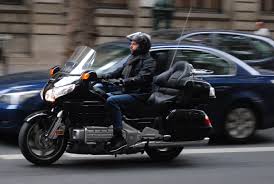 Sharing the road with all types of transportation is very important. Motorcyclists are more exposed than motorists and are therefore more likely to be seriously injured in accidents. Being aware of motorcycles on the road can drastically help reduce the chances of accidents involving motorcycles. Motorcycles also need to do their part to help motorists see them on the road. Wearing reflective gear and staying out of vehicles blind-spots would help motorcycles be seen. Along with working together to reduce accidents, motorists and motorcyclists need to better understand each other’s laws to help reduce the animosity that sometimes can occur from sharing the road.
Sharing the road with all types of transportation is very important. Motorcyclists are more exposed than motorists and are therefore more likely to be seriously injured in accidents. Being aware of motorcycles on the road can drastically help reduce the chances of accidents involving motorcycles. Motorcycles also need to do their part to help motorists see them on the road. Wearing reflective gear and staying out of vehicles blind-spots would help motorcycles be seen. Along with working together to reduce accidents, motorists and motorcyclists need to better understand each other’s laws to help reduce the animosity that sometimes can occur from sharing the road.
There are a few different laws that motorcyclist have that motorists may not be aware of. Here is an example:
Intersection Laws
Since motorcycles are smaller and are less heavy than a normal size vehicle, intersection lights may not detect their presence leaving them to wait for unknown amounts of time until another vehicle may trigger the sensor. To help reduce this wait time at intersections, both cyclists and motorcyclists have the right to wait 90 seconds at the red light and if the sensor is not triggered within that amount of time, they are able to go through the light only if it is safe to do so. Motorists may think that the motorcyclist is running the light but in fact the aren’t held to the same exact law at intersections than a normal vehicle.
Along with the intersection laws, motorists have to think about a few other laws that don’t pertain to motorists. If you are a new motorcycle owner and are about to hit the open road, there are a few laws that you may need to research before heading out for that ride as many of these laws vary from state-to-state.
Helmet Laws
Helmets are a necessity for any rider, and every rider should consider riding with a helmet before hitting the open road. However, not every state requires motorcyclists to wear helmets. For instance, Utah’s Helmet Laws only require persons under the age of 18 to wear a helmet when operating or riding on a motorcycle. Riders should research if their state’s law is different and if wearing a helmet is required. That being said, all riders should consider wearing a helmet for the safety benefits it can provide if ever in an accident.
Passenger Laws
When thinking about going for a ride with your friend on their motorcycle, it’s not like a car where everyone can just jump in and go. There are different requirements for the motorcycle in order to carry passengers. The bike needs to be equipped with a passenger seat and secondary footrests. Having the requirements for the bike to carry passengers helps keep everyone safe while riding.
Eye Protection Laws
Wearing goggles or glasses while riding could help reduce the chances of glare blindness and also help keep things out of your eyes while riding. The requirement to wear eye protection also varies from state-to-state. In Utah, eye protection is not required. However, Colorado requires both the driver and the passenger of a motorcycle to be wearing eye protection when riding. Research what your state requires before heading out.
HOV Lane Laws
Cars are required to have a passenger in order to drive in the HOV lane in Utah. However, motorcyclists are able to drive in the HOV lane without any passengers.
Whether you are a new rider or not, all of these laws help keep riders safe. Be sure to research your state’s laws and requirements before riding your motorcycle. Laws are different between cars and motorcyclists so knowing what is required of you in each different type of transportation would be a great idea to keep everyone safe.
If you have been injured in a motorcycle accident due to someone else’s negligence, Christensen & Hymas is here to help you get the compensation you deserve. Call (801)506-0800 to schedule a free confidential consultation.
Image courtesy of Wikipedia
